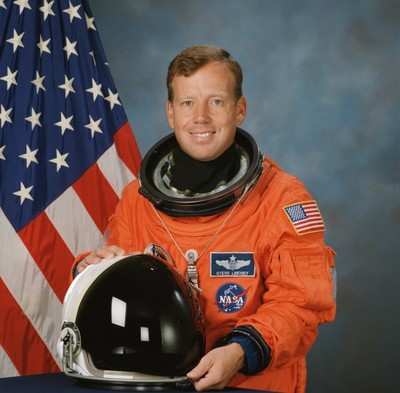NASA Makes Ready For Future Rescue Missions
 If NASA astronaut Steve Lindsey and
his crew have their way, the mission for which they've so
vigorously trained will never get off the ground.
If NASA astronaut Steve Lindsey and
his crew have their way, the mission for which they've so
vigorously trained will never get off the ground.
Sure, that sounds pretty odd for the normally gung-ho astronaut
corps, but consider: Lindsey, Mark Kelly, Piers Sellers and
first-time space traveler Michael Fossum will be standing by in
case the crew of STS-114 must be rescued from orbit.
The STS-114 mission will mark the space shuttles' return to
flight, more than two years after Columbia disintegrated upon
re-entry over eastern Texas and western Louisiana on February 1st,
2003.
If the worst happens to Discovery in the first shuttle mission
since the Columbia tragedy, Lindsey (below) and his crew might be
called on to launch in Atlantis in a flight designated STS-300.
They would head for the International Space Station -- where, in an
emergency, the crew of STS-114 would also head -- to retrieve the
astronauts and bring them home.
The rescue plan will be in effect for both STS-114 and the
following mission, which Lindsey will lead, STS-121. But the
Orlando Sentinel reports a rescue mission would be considerably
more challenging for NASA than the original return to flight or its
follow-up mission. One of the key questions NASA would have to
answer at the highest levels would be: Should we send another
vehicle into space without fully knowing what happened to the
shuttle in distress?

"You've come to one of the middle-of-the-night questions that
people wake up and ask themselves," Wayne Hale, deputy manager of
the shuttle program at NASA's Johnson Space Center in Houston, told
the Sentinel. "This question and the answer are going to depend
entirely on what the case is.... I think it will be a national
decision."
Could Columbia Have Been Saved?
In the fantasy world of Coulda-Shoulda-Woulda, that question is
the one that nags NASA officials even now. Shortly after the
Columbia accident, the board appointed to investigate asked NASA if
it indeed could have pulled off a rescue mission, had the Columbia
crew realized the fatal danger that awaited them upon re-entry. A
chunk of insulating foam which fell from the shuttle's external
tank on lift-off January 16th, 2003, had punched a hole in
Columbia's left wing. As the spacecraft re-entered the Earth's
atmosphere, super-hot gas seeped into the damaged wing structure
and tore the shuttle apart.

NASA answered the inquiry from the Columbia Accident
Investigation Board, saying, because the shuttle was flying a
rather long mission -- 16 days -- there were enough supplies on
board to last the crew of up to 30 days. The space agency might
indeed have been able to stage a "snap" launch. Atlantis
theoretically could have been hurried to the launchpad, provided
that, by the fourth day of the emergency, the Columbia astronauts
and Mission Control realized the damage to the shuttle was
fatal.
What about flying to the ISS? Nope. Columbia couldn't have done
it. The orbit was wrong for such a massive change and Columbia, the
first shuttle put into service, was too heavy to make it up to the
station's orbit.
The Columbia rescue mission would have meant that Atlantis would
have had to match orbits with the stricken shuttle, flying in
formation. The Columbia astronauts would have been forced to make a
series of daring spacewalks from one shuttle to the other, before
Atlantis itself returned to Earth.
The risks would have been mind-boggling. But Lindsey told the
Sentinel, "I suspect there would have been a long line of
astronauts, saying 'Send me. I'm ready to go.'"
Even so, said Hale, "Pulling off a successful rescue mission in
the amount of time we have available is certainly not a guaranteed
thing. If there is any other alternative that has a reasonable
probability of a happy outcome, I think you would rather avoid
that."
The STS-114 Rescue Plan
Assuming that a damaged Discovery could actually make it to the
space station so that the crew could be rescued, Mission Specialist
Sellers said making ready for a secure flight would be rather like
getting ready for any other mission. "When you break down all of
the things that you have to do, they're pretty much the same as for
the flight you were going to do in the first place," he told the
Sentinel. "The difference is in loading people up and transferring
crew from the station to the shuttle and modifying the shuttle a
little bit."
Atlantis would be modified to accommodate the rescued
astronauts. Extra crew couches would be bolted in place. Then of
course, there would be the possibility that the rescue shuttle
itself might get into trouble. Precautions for getting the rescued
crewmembers out of Atlantis in an emergency egress would have to be
made. The shuttle would be lighter than normal, given that its
projected payload would either not be on board yet or, if it had
already been loaded, would be unloaded before the rescue
attempt.

Sellers has no illusions about how easy a rescue mission would
be -- nor about the likelihood of success. "I think the biggest
challenges for STS-300 would be in terms of getting the vehicle
[Atlantis] ready to go on time in good shape," he told the Orlando
paper. "The people at the Cape have thought it through and say they
can do it, but it would be a lot of hard work."
Perhaps tantamount to any rescue mission would be the ability of
the stricken orbiter to make it to the ISS. There are, at this
point, no plans to rescue a shuttle still in orbit all by
itself.
 Classic Aero-TV: The Switchblade Flying Car FLIES!
Classic Aero-TV: The Switchblade Flying Car FLIES! ANN FAQ: Q&A 101
ANN FAQ: Q&A 101 ANN's Daily Aero-Term (04.12.24): Discrete Code
ANN's Daily Aero-Term (04.12.24): Discrete Code ANN's Daily Aero-Term (04.13.24): Beyond Visual Line Of Sight (BVLOS)
ANN's Daily Aero-Term (04.13.24): Beyond Visual Line Of Sight (BVLOS) ANN's Daily Aero-Linx (04.13.24)
ANN's Daily Aero-Linx (04.13.24)






